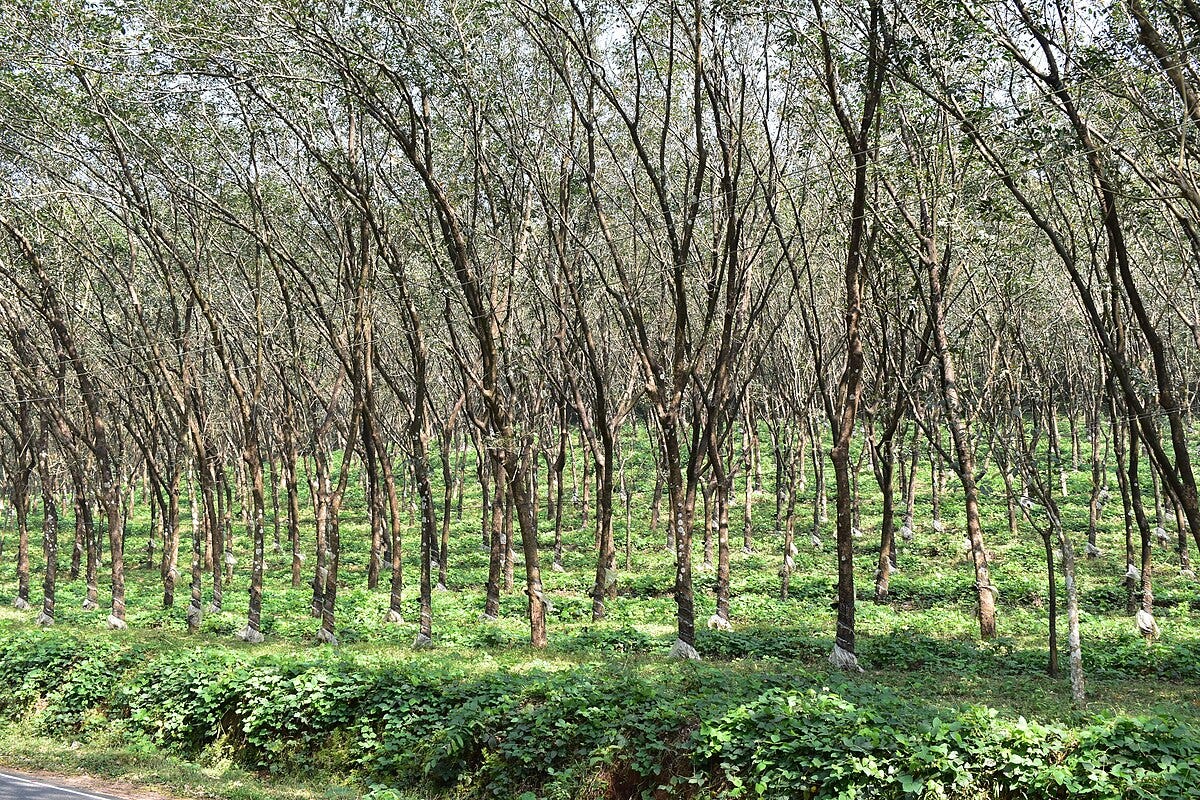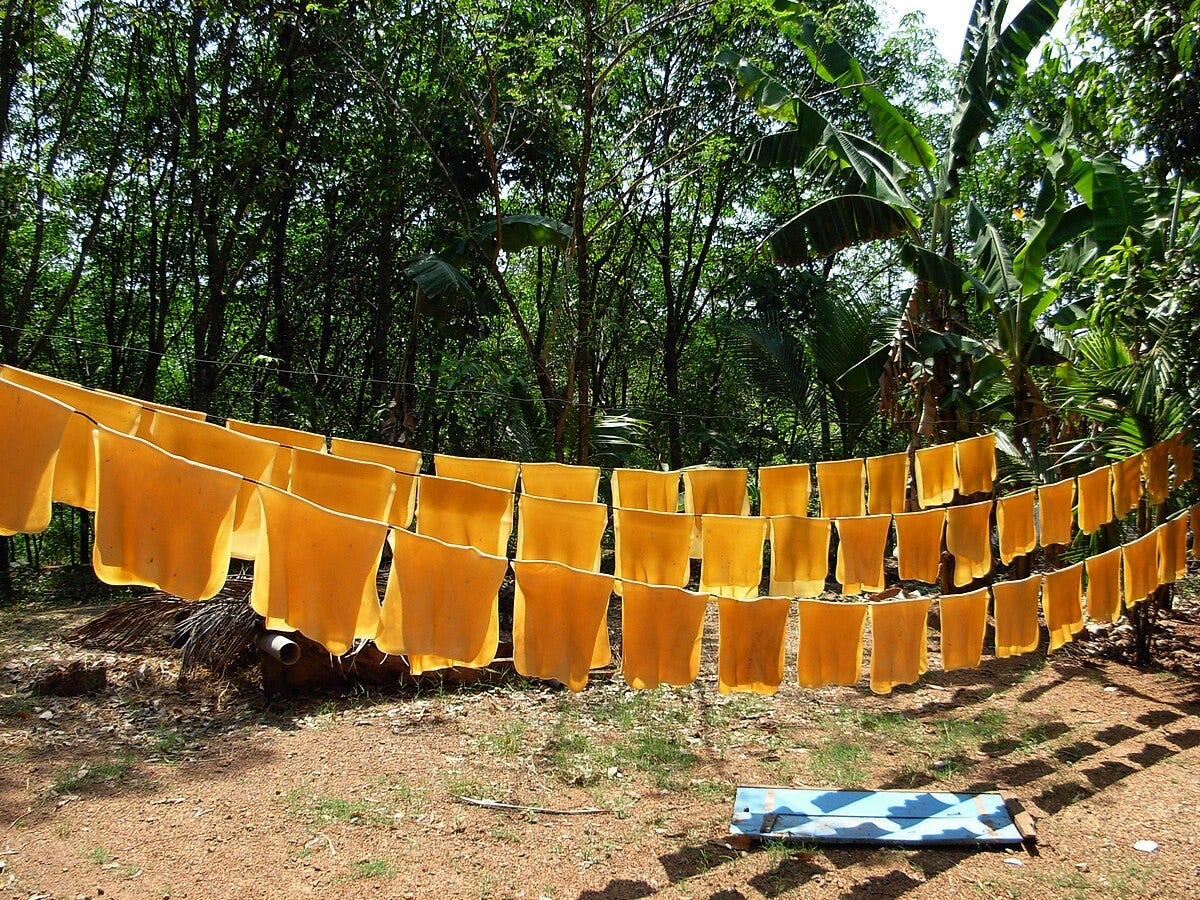Why Rising Rubber Imports is Bad for India's Economy
Rubber growers in Kerala can reduce impact from imports and climate change by also growing spices and fruits says Sunil Mani
(Photo: Rubber trees, Kerala. Courtesy Wikimedia Commons.)
November 1, 2025
By Sunil Mani*
TO LISTEN TO AN AUDIO VERSION CLICK ON BUTTON BELOW.
For more than a decade, rubber growers in India have faced falling incomes, even losses, due to competition from cheaper imports. In fiscal year 2015-16, for instance, growers in Kerala, the main producing state, suffered losses since the prices they received were below their cost of production.
In fiscal year ended March 2025, imports accounted for 43 percent of the country’s 2.3 million tonnes rubber consumption, up from just 10% in 2010. Nearly 60 percent of India’s 965,000 tonnes of rubber imports were natural rubber, with the rest being synthetic rubber, which is made from petrochemicals. Last fiscal year, India spent Rs 6,500 crore ($7.4 billion) on importing natural and synthetic rubber. The proportion of synthetic rubber in the country’s total imports ranges from 60 percent to three quarters.
Automotive tire manufacturers, including MRF, Apollo Tyres, CEAT, JK Tyre, Bridgestone India, and Michelin India, purchase two thirds of the rubber consumed. Bicycle tire manufacturers account for an additional 12 percent. The commodity is also used in the manufacture of footwear, belts, gloves and other products.
Given their dominant purchasing power and their ability to import rubber to manage prices and supplies, the tire manufacturers effectively determine the prices received by rubber growers in India. Also, since the 1.4 million growers farm small holdings, averaging around half a hectare, they have little bargaining clout with the buyers over prices.
The prices received by rubber growers in India started declining in 2010, following the ASEAN–India Trade in Goods Agreement. The pact included a reduction in tariffs on India’s natural rubber imports from the ASEAN countries. This led to cheaper supplies flooding India from Malaysia, Thailand, and Vietnam. Within five years, rubber imports rose nearly six-fold to 440,000 tonnes in fiscal year 2015, while domestic natural rubber output fell by a quarter to 560,000 tonnes. The Government of India’s withdrawal from active price support and reduction of subsidies worsened the economic plight of growers.
Growers in India responded by postponing the replanting of senile trees and decreasing tapping intensity—the proportion of tappable to tapped area fell from 100 per cent in 2013 to below 80 per cent by 2020. This partly caused a decline in productivity: the average yield per hectare decreased to 1,500 kilograms in 2024, from 1,800 kilograms in 2010.
A major reason for the relatively cheaper prices of ASEAN exporters is that the rubber in those countries is grown on large, mechanized, commercial plantations. In contrast, more than 90 percent of India’s rubber is harvested from small farms. It is also grown by around 540 estates, which are small, with an average size of 130 hectares. Rubber farming in India, being small scale, is inefficient and hence more expensive compared to in ASEAN countries.
However, rubber farms in India play a vital economic role since they provide income to more than two million people, including growers and labourers. In fact, up until 2010, rubber was a stable source of income for growers. The trees require minimal maintenance once they mature after seven years. They are also relatively tolerant to drought, pests, and diseases.
(Photo: Tapping a rubber tree in Kerala. Courtesy Wikimedia Commons.)
India is a major producer of natural rubber. Last year, the country’s output was 875,000 tonnes from roughly 950,000 hectares in Kerala, Tamil Nadu, and the northeastern states. Also, manufacturers in India produced 580,000 tonnes of synthetic rubber, about 40 percent of total domestic rubber output.
Growers tap the rubber trees to extract latex, which is then coagulated into sheets or processed into ribbed smoked sheets. From the farms, the sheets are collected by local traders who handle storage, grading, and initial quality checks. The traders then supply rubber to manufacturers of tire and non-tire rubber goods and large-scale processors.
The first commercial-scale rubber plantation in India was established in 1902 at Thattekkad, Kerala. The plantation area rose substantially, especially during World War Two; estimated to be around 65,000 hectares by the end of the war.
In 1947, the newly independent Government of India established the Rubber Board to coordinate and fund cultivation, processing, and marketing of the commodity. From then until the 1980s, state supervision aimed to protect domestic growers and to achieve self-sufficiency. Minimum and maximum prices received by growers were fixed; imports were restricted; and a fee was collected from growers to fund research and development and welfare measures.
The Rubber Board has created over 300 hybrid clones, steadily increasing potential yield from about one tonne per hectare in the 1950s to as high as four tonnes, on some farms in recent years. By 2020, almost the entire cultivated area in India was replanted with the improved trees.
Since the post-independence price and other policies benefitted growers, India’s natural rubber output rose more than twelve-fold to 900,000 tonnes in fiscal year 2012. In six years, from fiscal year 2006 to fiscal year 2012, prices received by growers nearly tripled to Rupees 210 per kilogram. Kerala benefited the most with rubber cultivation expanding to around 400,000 hectares. Growers in the state also achieved the highest yield among major producing countries, averaging about 2,000 kilograms per hectare.
In the late 2000s, small growers, in the hilly regions of the North-Eastern states of Tripura, Assam, and Meghalaya, began planting rubber. This was partly due to the availability of new cold-resistant hybrid varieties of rubber trees, developed for the region by agronomists at the Rubber Board.
The geographical shift was also driven by lack of suitable farmland in Kerala and Tamil Nadu. While these two southern states once accounted for almost all of India’s natural rubber output, they currently supply about three-quarters of the domestic crop. However, yields of rubber farms in the North East are significantly lower than that in Kerala, which partly explains the declining overall rubber yields across India.
(Photo: Rubber sheets drying, Kerala. Courtesy Wikimedia Commons.)
Currently, growers in India receive an average farm gate price of roughly Rs 184 ($2) per kilogram, slightly above their cost of production. The prices could decline since both imports and domestic production of synthetic rubber are likely rising. This is because synthetic rubber has become cheaper due to falling crude oil prices; the NYMEX benchmark crude oil price average is around $65 so far this year, down from $94 in 2022.
Meanwhile, the Rubber Board seeks to raise the incomes of India’s growers by promoting the formation of Rubber Producer Societies and Group Processing Centres. These co-operatives seek to enhance processing standards and the bargaining power of the growers. By 2020, nearly 3,400 such groups were set up. But they account for only around four percent of India’s natural rubber production. Apparently, growers find selling through the co-operatives does not help them secure better prices.
Rubber trees thrive on rolling and undulating lands, typically between 300 and 800 meters above sea level, with areas above 600 meters being ideal. The crop requires deep, lateritic, and acidic soils with high fertility and good drainage. In addition, rubber grows best in a humid tropical climate, with temperatures ranging from 25 to 34°C and annual rainfall between 80 to 180 inches. Such soil and climate requirements have made the Southern state of Kerala well suited for rubber cultivation - so far.
However, scientists and the Rubber Board predict that by 2050 the ideal conditions for growing rubber will shift from Kerala to the hilly areas of the North-Eastern states. This is because climate change will likely cause hotter temperatures, erratic rains, and flooding in Southern India. As a result, the decline in rubber yields and incomes may accelerate in Kerala.
In Southern India, the Rubber Board is making efforts to help rubber growers earn additional income by also growing crops such as spices, banana, tapioca, and pineapple as well as from planting timber and fuel wood, and from beekeeping and aquaculture. Growers who follow such practices, alongside tending to their rubber trees, can diversify their income from the same landholding.
If growers in India continue to make little profits, even lose money, due to rubber imports, natural rubber output in the country will shrink while demand continues to rise. The country will become more dependent on rubber imports, despite the official policy rhetoric about self-reliance.
Rising rubber imports hurts rubber growers and job creation in India as well as raises the country’s trade deficit. As it is, India imports nearly four fifths of its five million barrels per day of crude oil consumption. In large part due to the rising cost of oil imports, the value of the Indian Rupee has declined against the world’s major currencies – from Rupees 3 per US dollar in 1947 to Rupees.88 currently.




